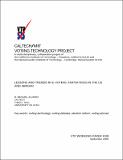| dc.description.abstract | Since the 2000 election, there has been a debate over the role of voting technology in the election process. In 2000 and 2001, this debate focused on the deficiencies associated with paper ballots—especially the punch card—and the ballot errors associated with these ballots. However, this debate has shifted since 2002 to a conflict between concerns about the accessibility of voting technologies versus their security, especially electronic voting technologies. This shift in the debate over voting technologies can be seen in the quantity and tone of media coverage of this issue, with coverage swinging markedly against electronic voting in 2003 and 2004. The accessibility versus security debate is familiar ground for interest groups, scholars, and players in the election policy domain. Similar debates previously occurred over modification of voter registration and related voter access issues. | en_US |

